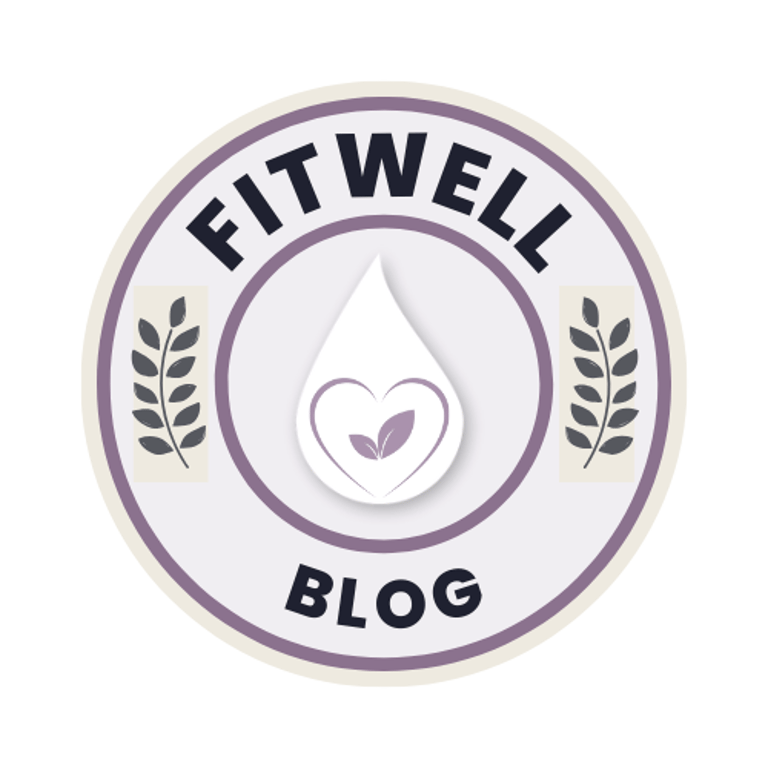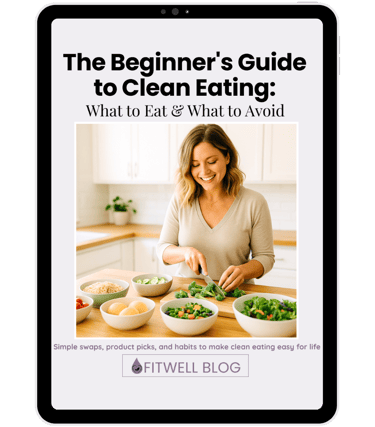The Beginner's Guide to Clean Eating: What to Eat & What to Avoid
Discover the beginner’s guide to clean eating—what to eat, what to avoid, plus tips, product picks, and habits for lasting health. This guide blends the principles behind the most effective whole-food diets — without labeling or restricting you to one plan.
NUTRITION
8/14/20258 min read


Why Clean Eating Is Easier Than You Think
For decades, we were told fat was the enemy. That eating butter, steak, or whole eggs would clog our arteries and expand our waistlines. The truth? We were lied to. Healthy fats are essential to hormone balance, brain function, and overall vitality. Fat doesn’t make you fat — processed junk, refined carbs, and industrial seed oils do.
Clean eating is about returning to the way humans were designed to eat — nutrient-dense whole foods, quality proteins, healthy fats, and colorful vegetables. This guide blends the principles behind the most effective whole-food diets — without labeling or restricting you to one plan.
This post may contain affiliate links. That means if you click and purchase, we may earn a small commission—at no extra cost to you.


What Is Clean Eating, Really?
Clean eating is not a fad diet or a calorie-counting game. It’s a lifestyle focused on whole, minimally processed foods that nourish your body and keep blood sugar stable. It’s about eating real food — the kind your ancestors thrived on — and skipping the modern fake foods that disrupt health.
A simple way to remember it: If it came from the earth, roamed the land, or swam in the sea, it’s likely a good choice.
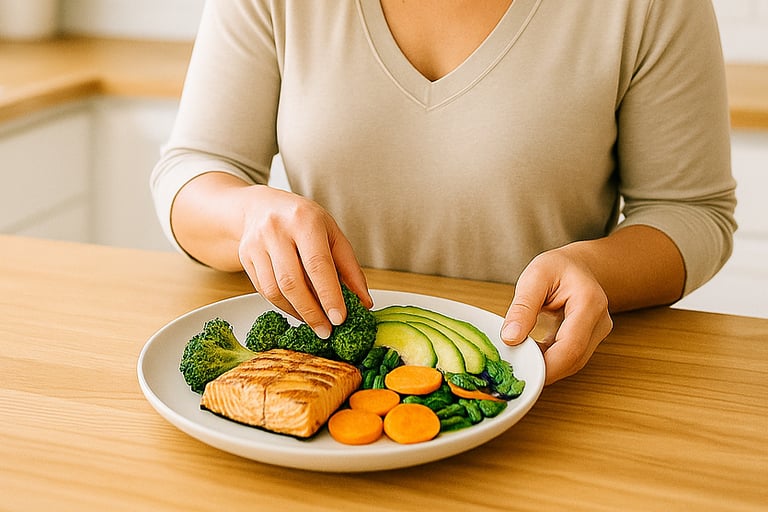

Foods to Enjoy
Your clean eating staples should include:
Fresh fruits & vegetables – Nutrient-packed plants that fuel your cells and support digestion.
Animal proteins – Grass-fed beef, lamb, bison, pastured pork, poultry, and wild-caught fish; vital for muscle repair, hormone health, and metabolism.
Eggs – Nature’s perfect protein, rich in vitamins and healthy fats.
Healthy fats – Avocado, nuts, seeds, olive oil, coconut oil, grass-fed butter, ghee, and tallow; crucial for hormones, brain function, and satiety.
Low-glycemic whole-food carbs – Sweet potatoes, squash, beets, and berries; provide steady energy without spiking insulin.
Hydration boosters – Water, herbal teas, and mineral-rich electrolyte mixes like Hydrated to keep your body balanced.
Protein powder – A quick, easy way to hit your protein target on busy days. Look for clean brands with minimal ingredients, such as Equip Protein, Peak Performance Protein, Isopure Zero Carb, or for a plant-based option, Ka'Chava.
Collagen peptide powder – Supports joint health, skin elasticity, and gut lining. Recommended options include Vital Proteins Collagen Powder and Anthony's Collagen Powder for high-quality, clean-sourced collagen.
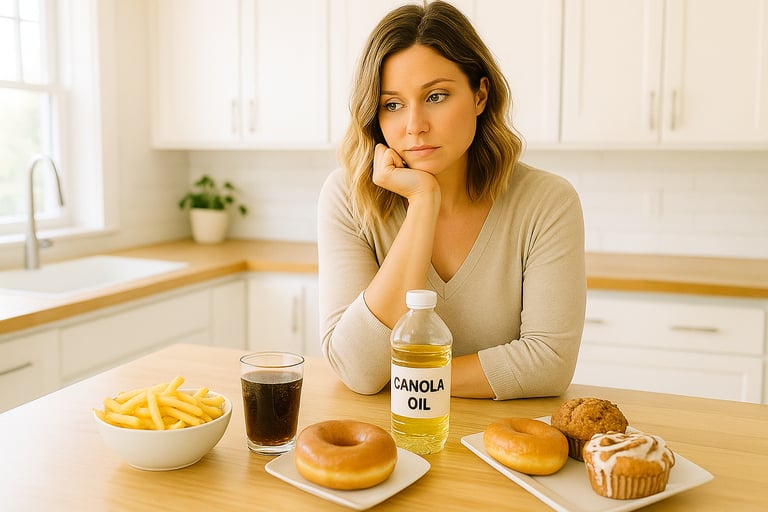

Foods to Avoid (Most of the Time)
These foods are best minimized because they create inflammation, disrupt blood sugar balance, harm gut health, and can interfere with natural hormone function. By understanding why they’re harmful, it’s easier to make lasting changes.
Highly processed snacks and sweets – Loaded with sugar, refined flour, and artificial additives.
Sugary beverages – Soda, juice cocktails, energy drinks.
Refined carbs – White bread, pastries, crackers, pasta made with bleached flour.
Harmful seed oils – Canola, soybean, corn, sunflower, margarine — originally made for machinery, not humans.
Highly refined, inflammatory, and nutrient-poor, these oils have been linked in research to increased risk of heart disease due to their high omega-6 content, oxidation during processing, and ability to promote chronic inflammation that damages blood vessels over time.
Artificial additives and colors – Provide no nutrition and may trigger sensitivities.
Certain dyes, like Red 40 or Yellow 5, have been linked to hyperactivity in children and behavioral issues, while some artificial preservatives have been associated with allergic reactions, migraines, and even potential endocrine disruption over time.


How to Transition Without Overwhelm
Preplan your meals and snacks — don’t wait until you’re starving, or you’ll likely grab the nearest (and usually unhealthiest) thing.
Start with one swap per meal — replace margarine with grass-fed butter, white rice with cauliflower rice. Keep healthy pasta substitutes on hand, or do something like chickpea or zucchini noodles, to replace refined pasta in your favorite recipes.
This tip really depends on you — some of us need to switch cold turkey because our brains go hog wild with food🙋♀️, while others do better with gradual swaps. Know thy self!
Follow the 80/20 rule — 80% nutrient-dense whole foods, 20% flexibility.
For example, if you eat three meals a day, that’s about four to five meals a week where you can enjoy a treat or a less-than-perfect option without guilt. That doesn’t mean full-on 4–5 cheat meals — it means allowing yourself a small indulgence within those meals, like choosing white rice instead of cauliflower rice, or enjoying a dinner roll in place of a low-carb wrap.
Again, knowing yourself is key here — my brain can’t do one indulgence without wanting alllll the indulgences, so for me, even a single treat can trigger a spiral.
Keep clean snacks handy — hard-boiled eggs, nuts, jerky, carrot sticks, fresh berries. A hard-boiled egg cooker can make this super simple. For on-the-go convenience, my favorite beef jerky sticks are from Country Archer — clean ingredients, high protein, and travel-friendly.


Key Habits That Make Clean Eating Easy
Meal Planning & Prep – Cook in batches so you always have clean options ready.
This habit is key to success on ANY diet or weight loss plan. Like they say, “fail to plan, or plan to fail” (or something like that). Glass food prep containers keep meals fresh longer and make grab-and-go easy.
Macro Awareness – Prioritize protein and healthy fats while keeping carbs nutrient-dense and unprocessed. Protein is so important — most of us chronically eat too little. Aim for about 1 gram of protein per pound of your ideal (or goal) body weight. For example, if your goal is 150 lbs, aim for 150 grams of protein daily. Protein powder is a great tool for hitting your target, especially post-workout.
We could spend a year talking about macros, but the basics are proteins, carbs, and fats. You don’t have to track every meal forever, but if you want to see where your true numbers are, tracking for a few days gives you a solid baseline. Using a food scale is super helpful — you can measure down to the gram how much protein, carbs, or fats you’re eating. Pair this with a free tracking app like Carb Manager for accurate data.Stay Hydrated – Drinking plain water alone doesn’t fully support hydration, because hydration depends on proper electrolyte balance. Mineral-rich options like Hydrated, other electrolyte supplements, or adding a pinch of Celtic Salt or Redmond's Real Salt to your water can keep electrolytes balanced and improve true hydration. A quality water bottle, like this Yeti Rambler with Chug Cap, helps you track and increase your daily intake. (Read: Hydration Hacks)
Time Your Meals – Many thrive on spacing meals out or intermittent fasting. Again, don’t wait until you’re starving before eating — most of us will overindulge when we’re super hungry.
Give intermittent fasting a try by starting with a simple 12-hour fast: eat dinner, go to bed, and have your next meal at the 12-hour mark (like mid-morning). This is an easy way to fast by using your natural sleep time, which is already a fasted period.
A great resource for women learning how to fast in a way that supports hormone health is the book Fast Like A Girl — it explains how to align fasting with your cycle and unique female needs.


Common Clean Eating Mistakes to Avoid
Avoiding fat and relying on low-fat processed products. Fat is not the enemy — eating fat doesn’t make you fat. That was a marketing lie we were fed in the 1980’s. Healthy natural fats are vital for hormones and overall health, while processed fats, especially toxic seed oils, are detrimental to your body.
Good fats include real butter, ghee, olive oil, coconut oil, and beef tallow for high-heat cooking.
Fun fact! I made the tastiest "fried chicken" EVER in beef tallow — using chicken leg quarters, no breading, and not even seasoning them. I filled a pot with beef tallow, enough to cover the leg quarters, and fried until done. The best fried chicken EVER…
slap-yo-mama good!
Bad fats include canola oil (pretty much the worst one), vegetable oil, palm oil, sunflower oil, peanut oil, and similar refined seed/vegetable oils.
Eating too many “healthy” packaged snacks. Even healthy pre-packaged foods are heavily processed and usually contain some sort of preservative — fresh is always best.
Not getting enough protein. Again, protein is so important — aim for 30–40 grams of protein (at a minimum) at each meal to meet daily needs and support muscle, hormones, and metabolism.
Skipping hydration. Being dehydrated does us no favors for health — most processes in the body need proper hydration and minerals to operate correctly.
We lose significant water daily just from basic bodily functions like breathing, sweating, and digestion, and even more during hot summer months or when active.
The bottom line: steer clear of most things that come in a bottle, box, or package — if it could survive the apocalypse, it’s probably not doing your health any favors.


Clean eating is about returning to our roots — eating the foods humans are biologically designed to thrive on. When you focus on whole, nutrient-dense foods and ditch processed junk, your body naturally finds balance.
Clean Eating Product Roundup
Here’s a quick reference list of all the recommended products from this guide, so you can easily find the tools and foods to support your clean eating journey.
Some of these links may be affiliate links, which means we may earn a small commission if you purchase through them, at no extra cost to you.
Protein Powders
Equip Protein – Clean, minimal ingredients, great for daily use.
Peak Performance Protein – High-quality whey protein option.
Isopure Zero Carb – Perfect for low-carb or keto lifestyles.
Ka'Chava – A plant-based superfood meal shake packed with nutrients.
Collagen Powders
Vital Proteins Collagen Powder – Supports skin, joints, and gut health.
Anthony's Collagen Powder – High-quality, clean-sourced collagen.
Snacks
Country Archer Beef Jerky Sticks – Clean ingredients, high protein, great for on-the-go.
Cooking & Meal Prep Tools
Hard-Boiled Egg Cooker – Simplifies protein snack prep.
Glass Food Prep Containers – Keep meals fresh and organized.
Food Scale – Helps measure protein, carbs, and fats accurately.
Hydration Essentials
Hydrated – Natural electrolyte mix for balanced hydration.
Celtic Grey Salt – Mineral-rich addition to water.
Redmond's Real Salt – Another mineral-rich option for enhancing hydration.
Yeti Rambler with Chug Cap Water Bottle – Keeps water cold and helps track intake.
Healthy Fats
Beef Tallow – Great for high-heat cooking, rich flavor.
Pasta Alternatives
Pete's Pasta – Zero carb swap for traditional pasta.
Recommended Reading
Fast Like A Girl by Dr. Mindy Pelz– Teaches women how to fast in a way that supports hormone health.
This list is your go-to resource to make clean eating easier, tastier, and more sustainable. Stock your kitchen with these staples and watch how effortless healthy living becomes!
More Fitwell Reads:
References:
© 2025 FitWell. All rights reserved.
This website may include affiliate links to various companies. When you make a purchase through these links, we may receive a small commission, at no additional cost to you.
Medical Disclaimer:
The information provided on this website is for educational purposes only and is not intended to diagnose, treat, cure, or prevent any disease. Always consult with a qualified healthcare professional before starting any new supplement, diet, or wellness program.
